ELECTRONIC PRESENTATION SLIDES AND RELATED MATERIAL
Published on September 12, 2011
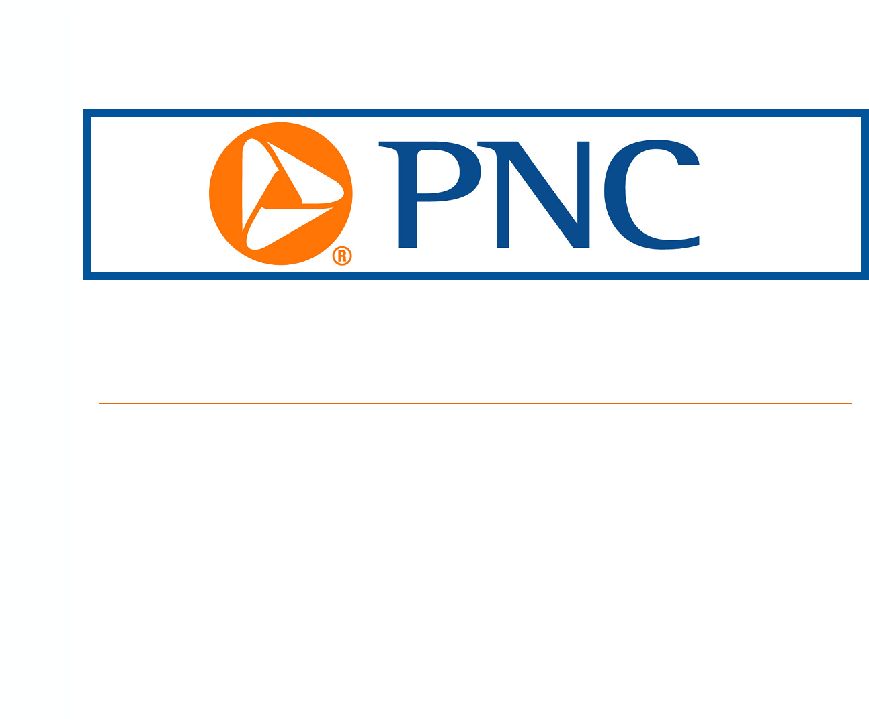
The PNC
Financial Services Group, Inc. Barclays Capital
Global Financial Services Conference
September 12, 2011
Exhibit 99.1 |

2
Cautionary Statement Regarding Forward-Looking
Information and Adjusted Information
This presentation includes snapshot information about PNC used by way of
illustration. It is not intended as a full business or financial review and
should be viewed in the context of all of the information made available by PNC in its SEC filings. The presentation also contains forward-
looking statements regarding our outlook for earnings, revenues, expenses, capital levels,
liquidity levels, asset quality and other matters regarding or affecting PNC and its
future business and operations. Forward-looking statements are necessarily subject to numerous assumptions,
risks and uncertainties, which change over time.
The forward-looking statements in this presentation are qualified by the factors affecting
forward-looking statements identified in the more detailed Cautionary Statement
included in the Appendix, which is included in the version of the presentation materials posted on our corporate website at
www.pnc.com/investorevents. We provide greater detail regarding some of these factors in
our 2010 Form 10-K and 2011 Form 10-Qs, including Risk Factors and Risk
Management sections of those reports, and our subsequent SEC filings. Our forward-looking statements may also be subject
to other risks and uncertainties, including those we may discuss in this presentation or in
SEC filings, accessible on the SECs website at www.sec.gov and on PNCs
corporate website at www.pnc.com/secfilings. We have included web addresses in this presentation as inactive textual
references only. Information on these websites is not part of this presentation.
Future events or circumstances may change our outlook and may also affect the nature of the
assumptions, risks and uncertainties to which our forward-looking statements are
subject. Forward-looking statements in this presentation speak only as of the date of this presentation. We do not
assume any duty and do not undertake to update forward-looking statements. Actual
results or future events could differ, possibly materially, from those anticipated in
forward-looking statements, as well as from historical performance. In this presentation, we sometimes refer to adjusted results to help illustrate the impact of
certain types of items, such as our third quarter 2010 gain related to the sale of PNC
Global Investment Servicing Inc. (GIS). This information supplements our results as reported in accordance with
GAAP and should not be viewed in isolation from, or a substitute for, our GAAP results.
We believe that this additional information and the reconciliations we provide may be
useful to investors, analysts, regulators and others as they evaluate the impact of these respective items on our
results for the periods presented due to the extent to which the items are not indicative of
our ongoing operations. We may also provide information on pretax
pre-provision earnings (total revenue less noninterest expense), as we believe that pretax pre-provision earnings, a non-
GAAP measure, is useful as a tool to help evaluate the ability to provide for credit costs
through operations. Where applicable, we provide GAAP reconciliations for such
additional information, including in the Appendix. In certain discussions, we may also provide information on yields and margins for all
interest-earning assets calculated using net interest income on a
taxable-equivalent basis by increasing the interest income earned on tax-exempt assets to make it fully equivalent to interest income earned
on taxable investments. We believe this adjustment may be useful when comparing yields
and margins for all earning assets. We may also use annualized, proforma,
estimated or third party numbers for illustrative or comparative purposes only. These may not reflect actual results.
This presentation may also include discussion of other non-GAAP financial measures, which,
to the extent not so qualified therein or in the Appendix, is qualified by GAAP
reconciliation information available on our corporate website at www.pnc.com under About PNCInvestor Relations.
|
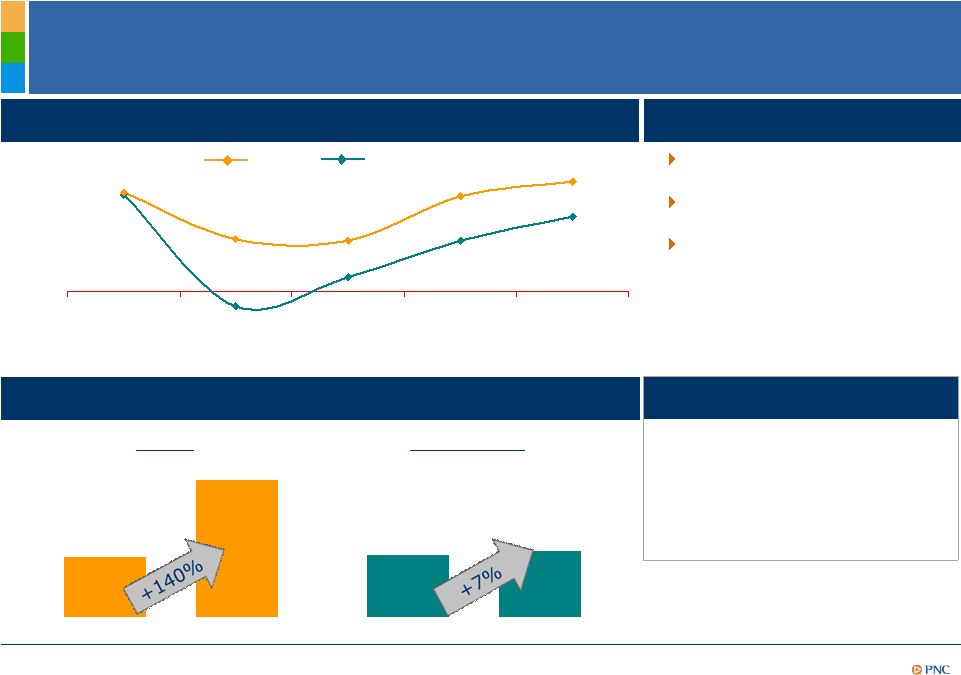
3
Industry Better Positioned in Current Environment
Valuation metrics
5
PNC
Peers
Price to book
82%
81%
Price to
tangible book
115%
121%
Dividend yield
2.8%
1.8%
-0.5%
0.0%
0.5%
1.0%
1.5%
2007
2008
2009
2010
2011
Return on average assets
2
3
PNC
Peer Average¹
Tangible book value per share
4
1.34%
0.91%
$18.55
$19.78
12/31/07
6/30/11
12/31/07
6/30/11
Peer Average¹
PNC
$17.91
$42.93
Stronger industry position
Stronger balance sheet
Improving profitability
Diversifying business mix
1.21%
1.18%
(1) Peer average represents average of banks identified in the Appendix. Source: SNL
DataSource. (2) Excludes BLK/BGI gain. (3) Excludes GIS gain. (4) Tangible book value
per share calculated as book value per share less total intangible assets per share. PNC believes that
tangible book value, a non-GAAP measure, is useful as a tool to help evaluate the amount,
on a per share basis, of intangible assets included in book value per common share.
Further information is provided in the Appendix. (5) Based on closing prices as of August 30, 2011.
|
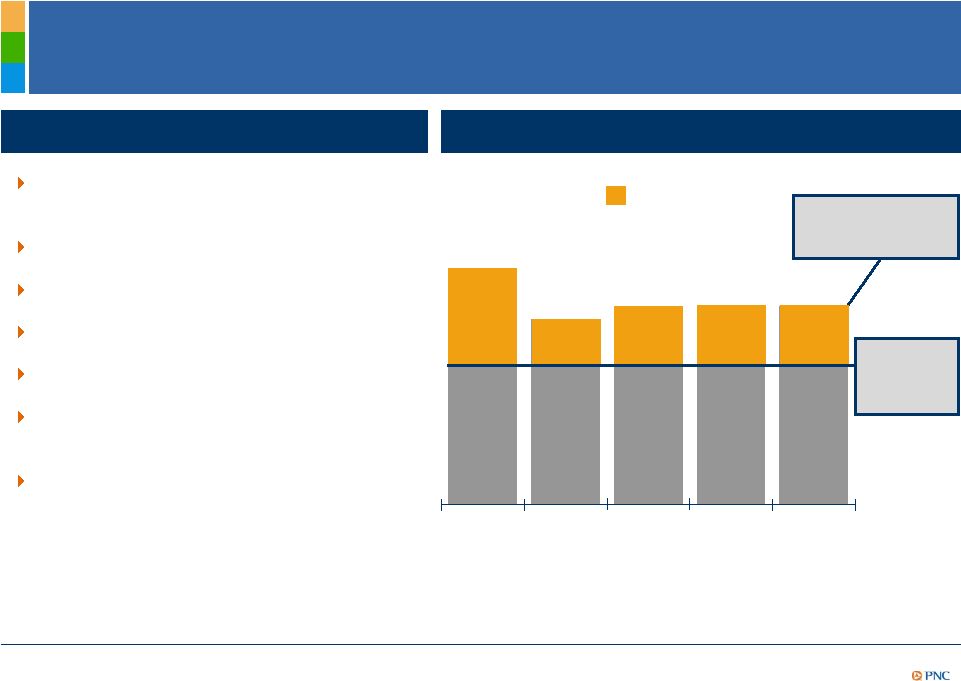
4
PNCs Differentiated Results
1H11 highlights
Net income of $1.7 billion increased by
18% YoY
Accelerated customer growth
Commercial loans grew
Net charge-offs decreased by 51% YoY
Tier 1 common increased to 10.5%
Increased common stock dividend
250%
Bank expansion through strategic
capital deployment
Return on tangible common equity¹
19%
15%
16%
16%
16%
2Q10
3Q10
4Q10
1Q11
2Q11
12%
Peer²
five
quarter
average
3
PNC 33% above
Peer²
five quarter
average
PNC
(1) Return on tangible common equity calculated as net income divided by (common equity less
intangible assets), annualized. PNC believes that return on tangible common equity, a
non-GAAP measure, is useful as a tool to help measure and assess a companys use of equity.
Further information is provided in the Appendix. (2) Peers represent banks identified in the
Appendix, as available. Source: SNL DataSource. (3) Excludes the $328 million
after-tax, $639 million pretax, GIS gain.
|
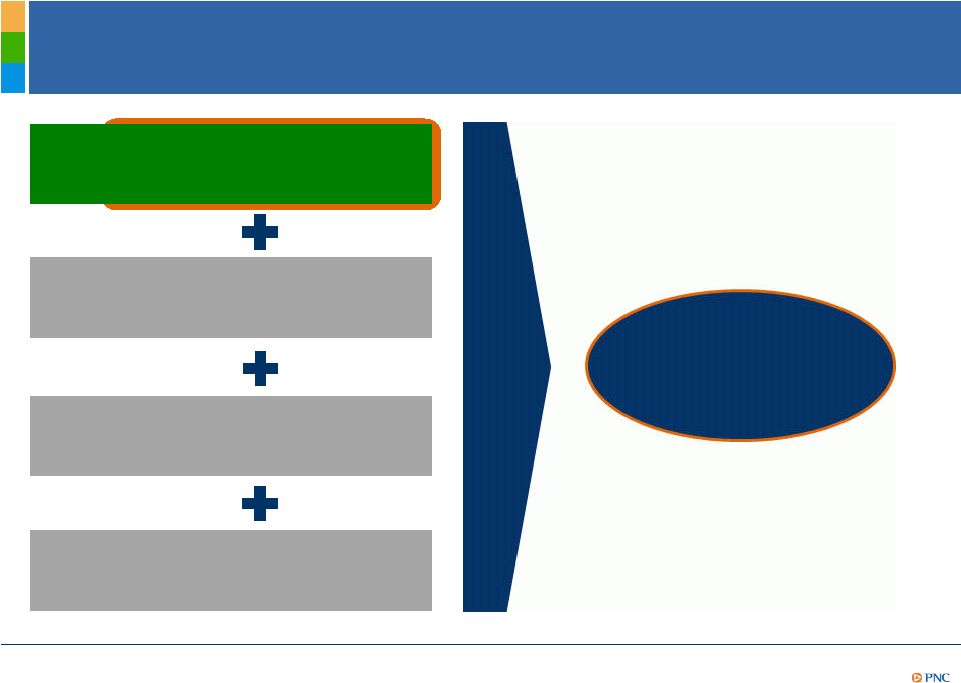
5
PNCs Proven Business Model Provides Levers in the
Current Environment
Positioned
for Quality
Growth
1
Growing customers
2
Managing risk
3
Continuous
improvement
4
Disciplined capital
management |
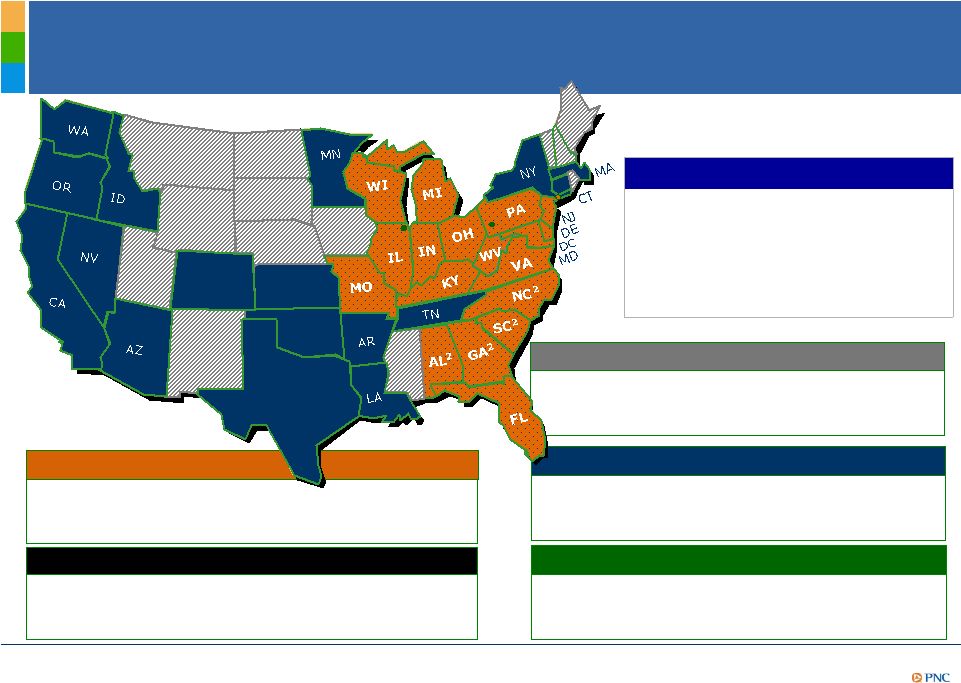
6
Proforma footprint covering approximately
half of the U.S. population²
Retail
Corporate & Institutional
A leader in serving middle-market
customers and government entities
One of the largest bank-held asset
managers in the U.S.
Asset Management
Residential Mortgage
National distribution capabilities
PNCs Powerful Franchise
CO
TX
KS
OK
BlackRock
A leader in investment management, risk
management and advisory services worldwide
June 30, 2011
U.S. Rank
Deposits
$182B
7
Assets
$263B
7
Branches
2,459
5
ATMs
6,707
5
th
th
th
th
1
(1) Rankings source: SNL DataSource; Banks headquartered in U.S. Assets rank excludes Morgan
Stanley and Goldman Sachs. (2) Given effect to pending RBC Bank (USA) acquisition,
which is subject to regulatory approvals and other customary closing conditions.
|

7
0
25
50
75
100
2003
2004
2005
2006
2007
2008
2009
2010
2011
2012
2013
Growing Customers
Responding to Changing
Customer Behaviors and Needs
U.S. banking transactions by channel (billions)
1
Mobile
Online
ATM
Call center
Branch
Forecast
Actual
Growth in electronic
channels continues to
reduce consumer check
payments
The percentage of
customers transferring
funds online nearly
doubled from 34% in 2005
to 67% in 2010
By 2012, checks are
expected to account for
only 17% of non-cash
transactions vs. 32% in
2006
Deposit transactions at
PNC branches declined at
an accelerated pace and a
5 year CAGR of (6.2%)
Changing customer behaviors
2
3
(1) Source: Tower Group, McKinsey & Company. (2) Source: Novantas. Annual
Multichannel Preference Survey as cited in Novarica, Consumer Usage of the
Mobile Banking Channel, January 10, 2010. (3) Source: Forrester Research Mobile Banking Forecast, 2010-2015.
|
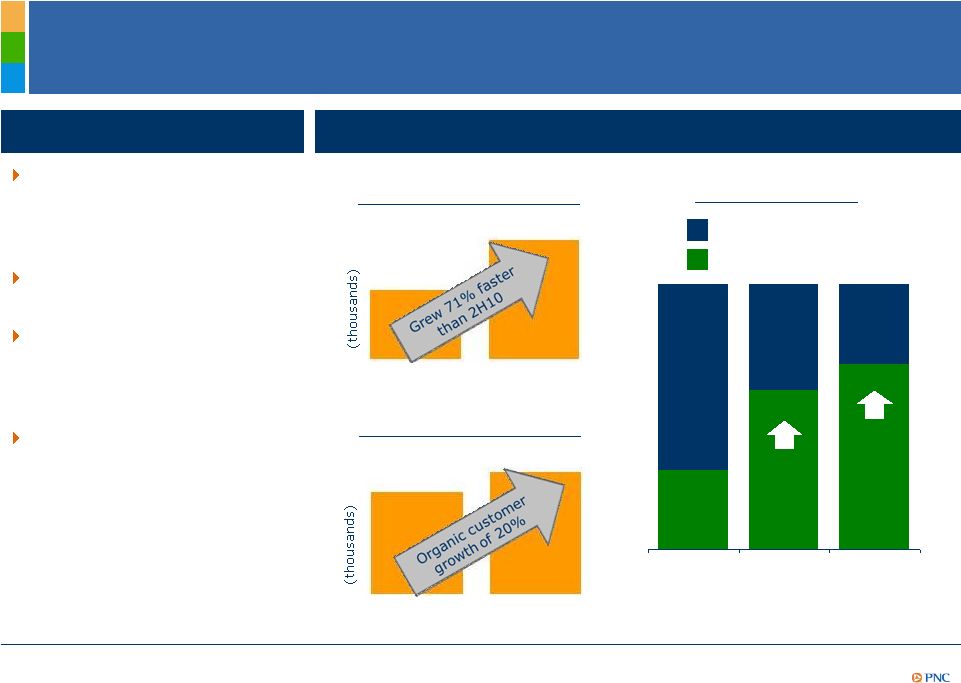
8
Growing Customers
Retail Banking
Yielding results
December
2010
Goal
Free checking
Relationship checking
July 2011
30%
63%
70%
Growth strategies
Expand market share and
share of wallet by providing
customers with more choices
and fair value
Deepen share of wallet in
the mass affluent segment
Capitalize on the launch of
integrated deposit products
and enhanced credit card
offerings
Fully leverage new
geographies and alternative
distribution channels
Organic checking
relationship growth
1,2
Growth in online bill
payment active customers
2H10
1H11
+130
+76
2Q10
2Q11
+1,045
+870
New originations
Period end
3
(1) Organic growth refers to consumer and small business customers excluding 32,000
relationships acquired by acquisition in 2Q11.
(2) Organic growth excludes 3,000 customers acquired by acquisition in 2Q11. (3) Relationship
checking refers to accounts with a committed balance level or self-service accounts
with lower cost of servicing.
|
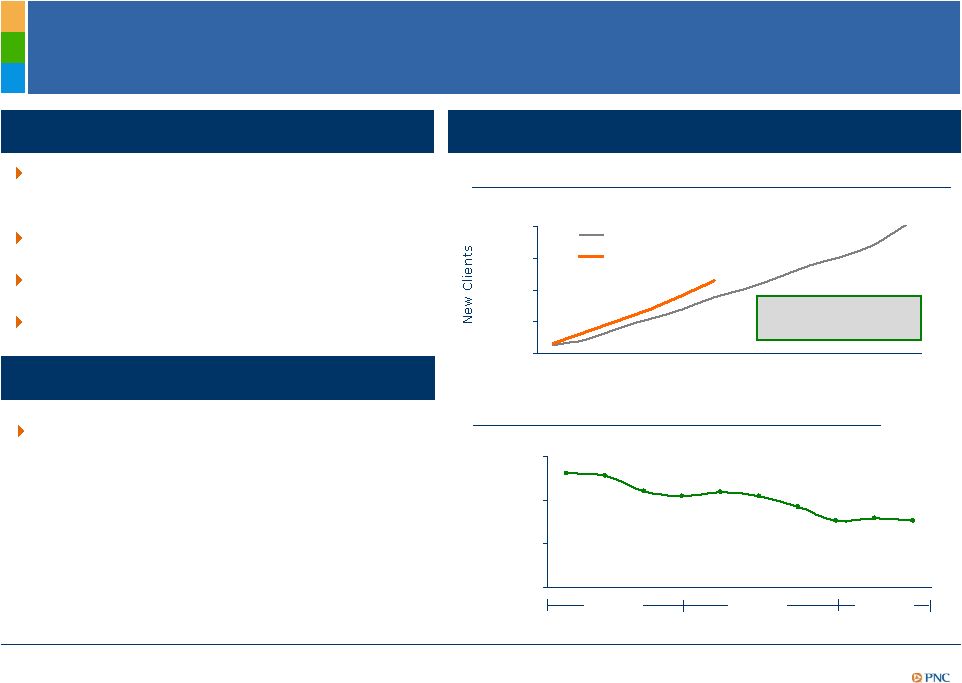
9
40%
45%
50%
55%
Yielding results
Corporate
Banking
New
Cumulative
Primary
Client
1
Growth
Growing
Customers
Corporate
&
Institutional
Banking
Growth strategies
Focus on cross-sell of existing
relationships
Achieve high growth customer additions
Invest in high potential markets
Focus on total relationship return
1Q
2Q
3Q
4Q
0
250
500
750
1,000
2010 Actual
2011 Actual
2009
2010
2011
As of June 30, 2011, 94% of all PNC
markets are ahead of first half sales
plans
²
Commercial loan growth increased
4% linked quarter and 9% first half
2011
²
New primary clients increased 29%
year over year
1H11 highlights
Loan commitments
grew 10% YoY
(1) Corporate banking primary client relationships are defined as corporate banking client
relationships with annual revenue generation of $10,000 or
more. (2) Corporate and Institutional Banking quarterly utilization rates reflect the consolidation of Market Street Funding
Corporation beginning January 2010. 2011 represents year to date results through June
quarter-end.
Corporate
and
Institutional
Banking
Utilization
Rates
2 |
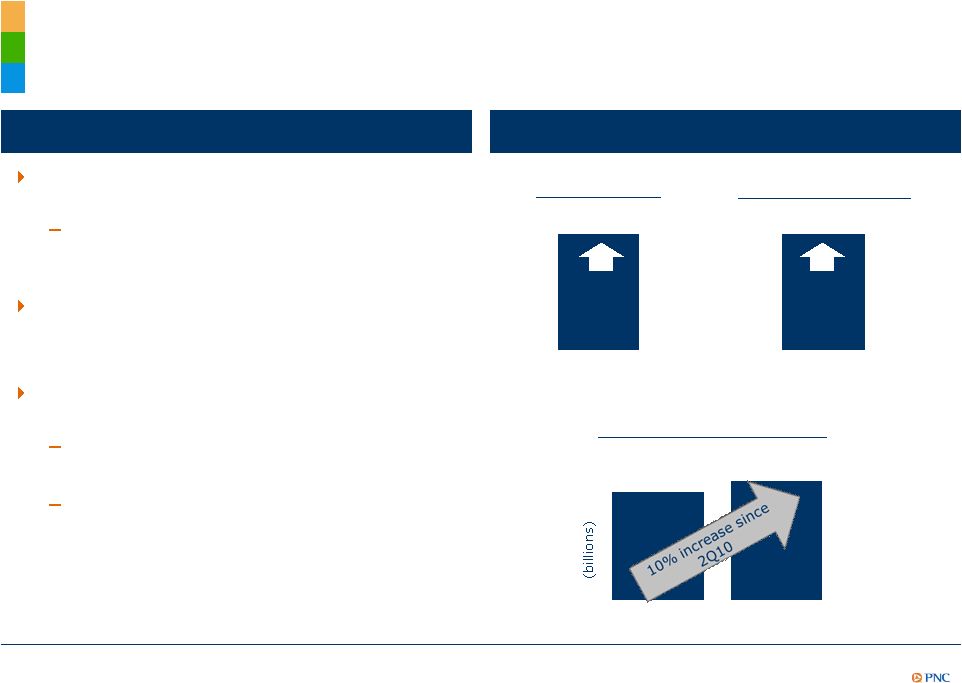

10
Growing Customers
Asset Management Group
(1) Referral sales are new sales to clients referred to AMG by Retail Banking or Corporate and
Institutional Banking. (2) New Primary clients are relationships with annual revenue of
$10,000 or more. Growth strategies
Expanding distribution in all markets with a
particular focus on high growth markets
Growing revenue through targeted market
opportunities and increased channel
penetration
Investing in innovation and technology
piloting Wealth Insight tool
Yielding results
Referral sales
1H11 vs. 1H10
104%
New primary clients
1H11 vs. 1H10
49%
Assets under administration
2Q10
2Q11
$219
$199
150 external
new
hires
in
the
first
half
of
2011
primarily front line talent
acquisition
Pilot
in
progress
with
roll-out
to
over
10,000 clients
Product
launch
in
3Q11
1
2 |
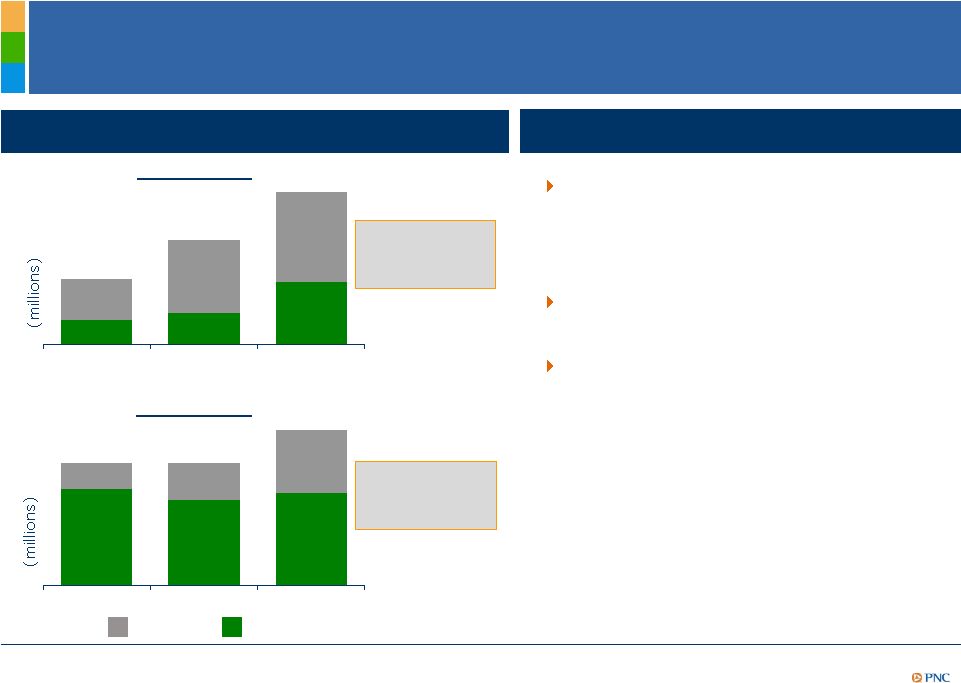
11
RBC Bank (USA)
Strategic Growth Opportunity
Priced Below Tangible Book Value
Total
market
revenue
growth
for
C&IB
and
AMG
Projected
5-year
population
growth
4
of
6.5% more than 1.5 times the national
average and 5 times PNCs Retail
Banking footprint
Combined retail footprint covers 11 of
the
top
20
wealthiest
states
5
Commercial
market
opportunity
6
:
RBCs market opportunities
Fee
NII
$12
$21
$26
$18
$9
$7
2009
2010
2011
Florida
$19
$30
$44
New
primary
clients
up
17%
over
YTD10
3
$14
$20
$33
$48
$44
$50
2009
2010
2011
Chicago
$64
$64
$82
New primary
clients up 67%
over
YTD10
3
²
More than 500,000 small businesses
²
Approximately 4,000 mid-market and
2,000 corporate companies
2
1
(1) Year over year market revenue growth. (2) Year over year total new primary client growth.
(3) 2011 represents revenue growth for the six months ended June 30, 2011,
annualized. (4) Source: SNL DataSource (5) Top 20 states based on wealth holders with
>$1.5 million in net worth. Source: IRS Statistics of Income Division, August 2008.
(6) Source: SNL Financial and OneSource.
2 |
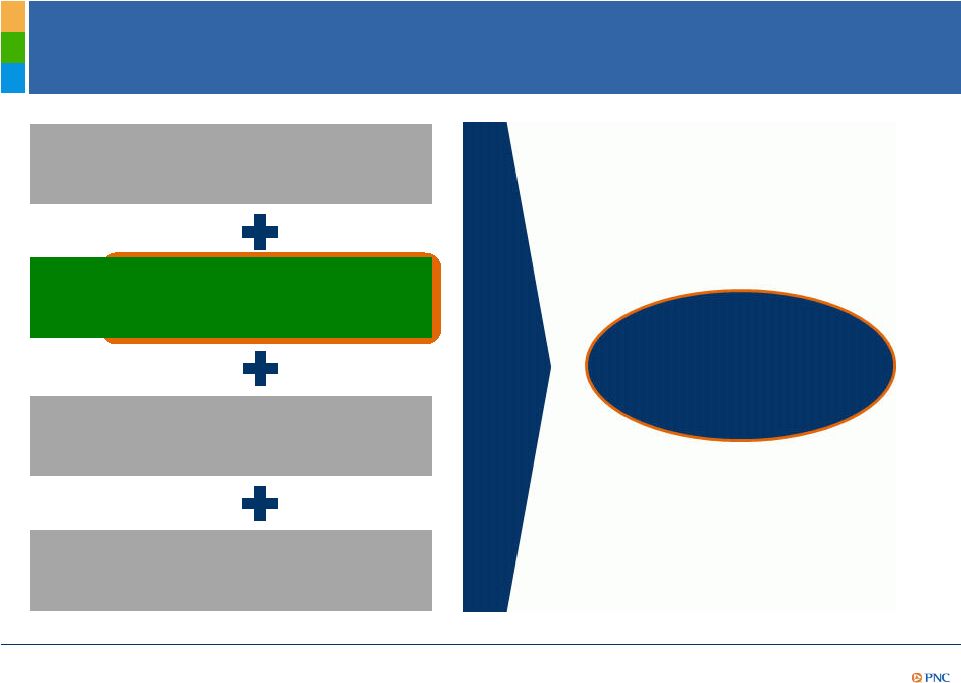
12
PNCs Proven Business Model Provides Levers in the
Current Environment
Positioned
for Quality
Growth
1
Growing customers
2
Managing risk
3
Continuous
improvement
4
Disciplined capital
management |
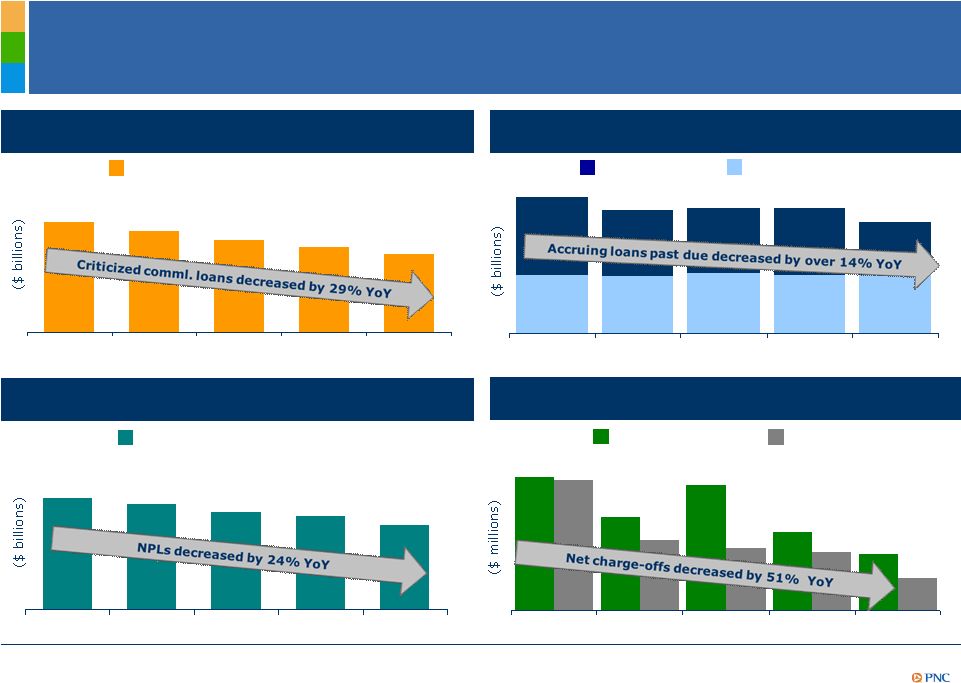
13
Managing Risk -
Credit Trends Continue to Improve
$791
$533
$442
$421
$840
$614
$414
$486
$280
$823
2Q10
3Q10
4Q10
1Q11
2Q11
Nonperforming loans
1,3
Provision and net charge-offs
Criticized commercial loans
30-89 Days
90 Days +
Accruing loans past due
1,2
$2.7
$2.6
$2.7
$2.6
$2.6
$2.2
$1.8
$1.8
$1.9
$1.5
2Q10
3Q10
4Q10
1Q11
2Q11
As of quarter end except net charge-offs, which are for the quarter. (1) Loans acquired
from National City that were impaired are not included as they were recorded at
estimated fair value when acquired and are currently considered performing loans due to the accretion of interest in
purchase accounting. (2) Includes loans that are government guaranteed/insured, primarily
residential mortgages. These loans totaled $2.7 billion in 2Q11. (3) Does not include
loans held for sale or foreclosed and other assets. Effective in 2011, excludes residential real estate
loans
accounted
for
under
the
fair
value
option.
(4)
Criticized
loans
are
ones
that
we
consider
special
mention,
substandard
or
doubtful.
$15.0
$16.4
$13.7
$12.7
$11.7
2Q10
3Q10
4Q10
1Q11
2Q11
Criticized
Commercial
loans
4
Provision
Net charge-offs
2Q10
3Q10
4Q10
1Q11
2Q11
Total nonperforming loans
$5.1
$4.8
$4.5
$4.3
$3.9 |
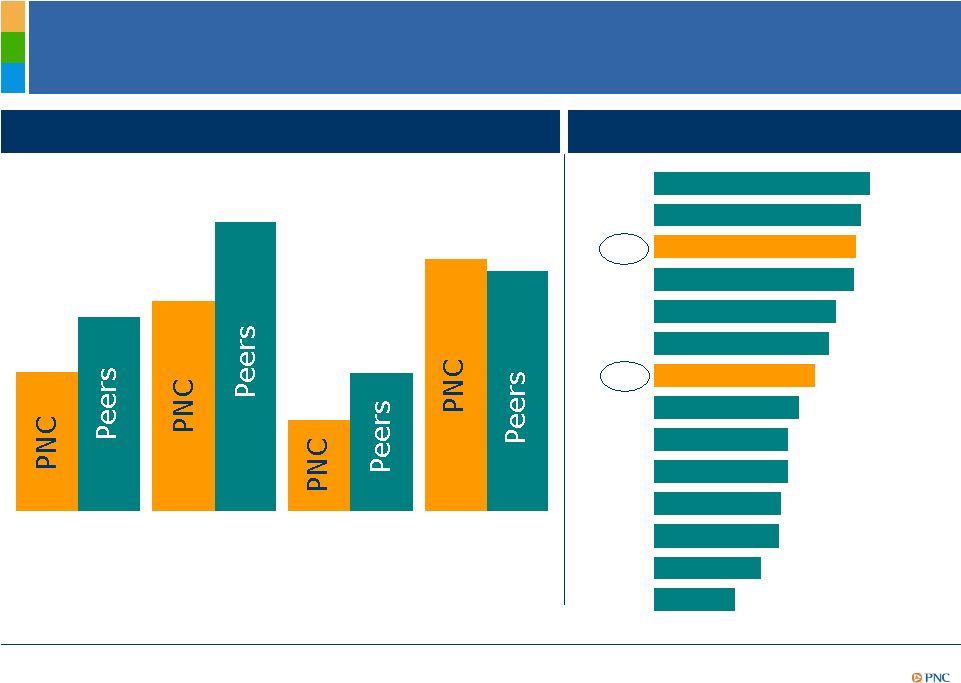
14
Industry Leading Performance
Nonperforming
loans²
to total
loans
Nonperforming
assets²
to total
assets
Net charge-
offs to average
loans
Allowance for
loan and lease
losses³
to
loans
2Q11 reserves/loans
Key 2Q11 credit metrics
1.70%
2.37%
2.57%
3.53%
1.11%
1.69%
3.08%
2.93%
(1) As of or for the quarter ended June, 2011. Net charge-offs to average loans
percentages are annualized. Peers represents average of banks identified in the
Appendix, as available. Sources: SNL DataSource, company reports. (2) Does not include purchased impaired loans or loans
held for sale. (3) Includes impairment reserves attributable to purchased impaired loans.
Loans PNC acquired from National City that were impaired are purchased impaired loans.
(4) 2Q11 reserves/loans would be 3.87% if adjusted to include the remaining marks on purchased
impaired loans. Further information is provided in the Appendix. Others have made
acquisitions and have marks on purchased impaired loans. No adjustments have been made
for those peers. 4.15%
3.96%
3.87%
3.84%
3.48%
3.35%
3.08%
2.78%
2.57%
2.57%
2.43%
2.39%
2.06%
1.56%
JPM
BAC
PNC
RF
COF
FITB
PNC
WFC
KEY
USB
BBT
STI
CMA
MTB
Includes purchased impaired
loan marks
4
1 |

15
Balance Sheet Management
Drivers
Current environment
Extended period of slow economic growth and low interest rates
Increase responsible lending to partially offset lower asset yields
Substantially reduce cost of funding to maintain net interest income
Maintain liquidity and strong capital position
Focus
on
risk-adjusted
commercial
loan
growth
to
mitigate
impact
of
securities
repricing
Lower funding cost
Strategies
Funding Cost Reduction
Opportunities
Expected 2012 Impact
(in millions)
Repricing CDs
$450-$500
Trust preferreds
Maturing debt
Deposit funding |
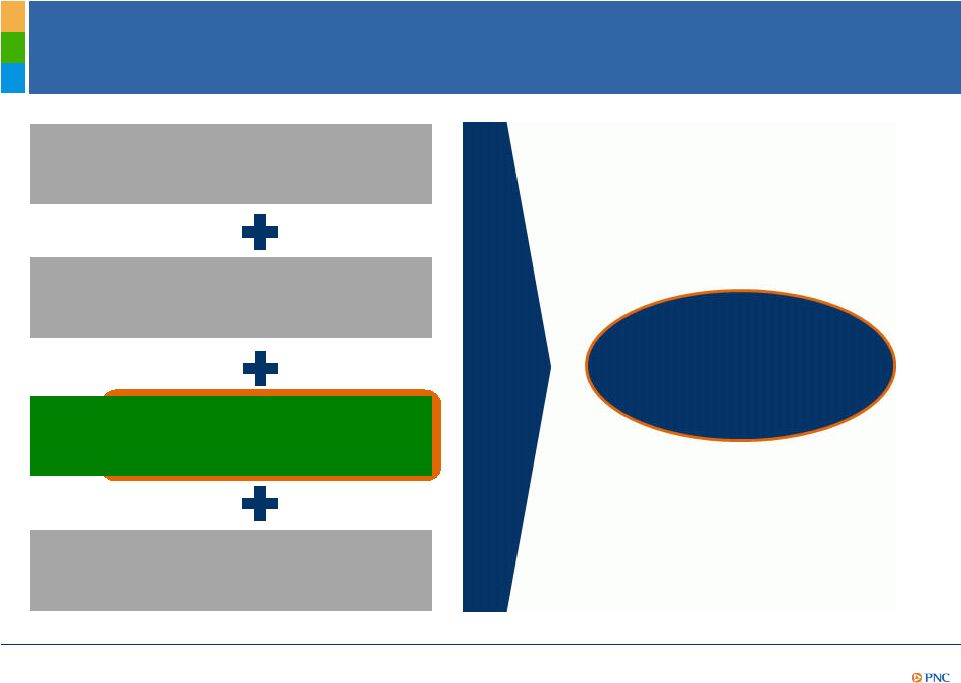
16
PNCs Proven Business Model Provides Levers in the
Current Environment
Positioned
for Quality
Growth
1
Growing customers
2
Managing risk
3
Continuous
improvement
4
Disciplined capital
management |
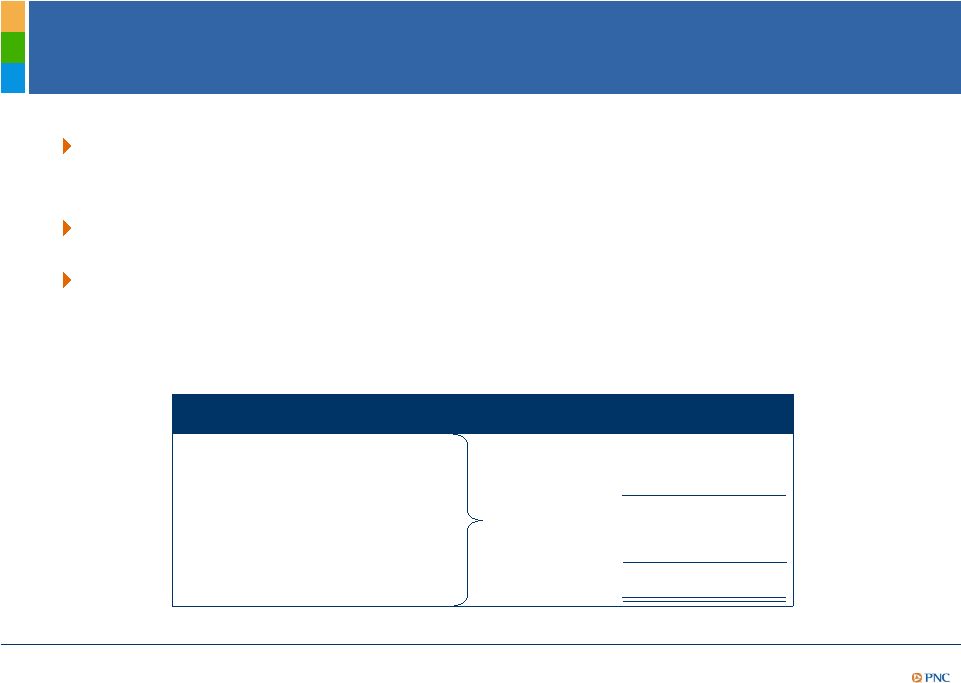
17
We are targeting expense reductions of $550 million or
approximately
6%
of
PNCs
estimated
2012
expense
base
2
These efficiencies provide the capacity to invest in future growth
Expense efficiencies are designed not to have an impact on
customers or revenue
Continuous Improvement
Expenses to Remain Flat in
2012
1
Expense Reduction Goals
2012 Financial Impact (in millions)
Business efficiency
$125
Operational efficiency
275
Total PNC initiatives
$400
RBC Bank (USA) integration
150
Total
$550
(1)
Does
not
include
legal
and
regulatory
related
contingencies,
and
Flagstar
and
RBC
Bank
(USA)
integration
and
operating
costs,
along
with capital actions. (2) The 2012 expense base includes the impact of the Flagstar and RBC
Bank (USA) operating costs. |
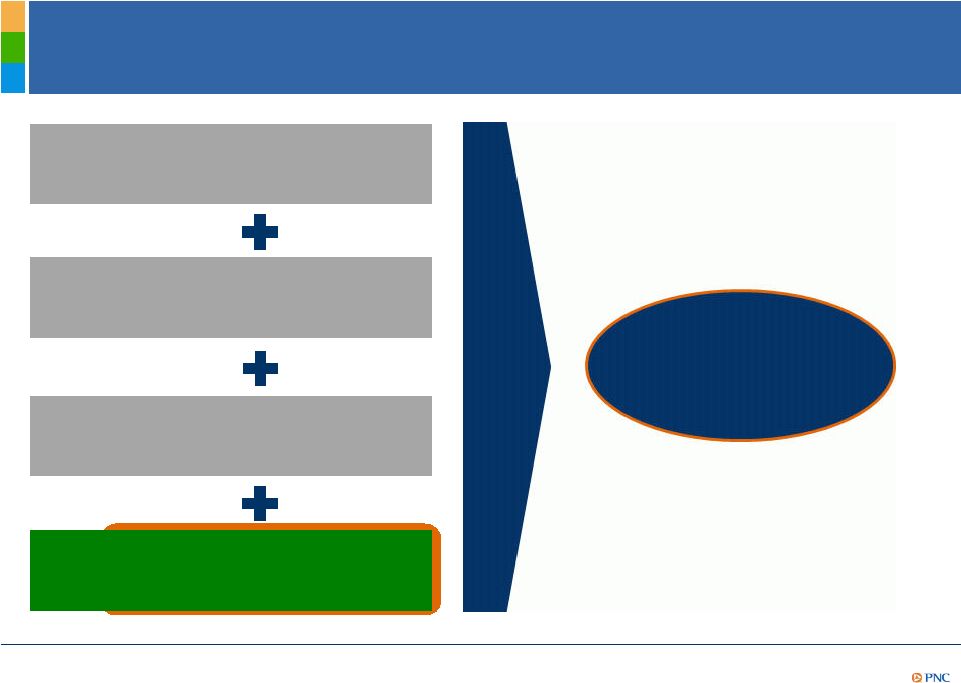
18
PNCs Proven Business Model Provides Levers in the
Current Environment
Positioned
for Quality
Growth
1
Growing customers
2
Managing risk
3
Continuous
improvement
4
Disciplined capital
management |
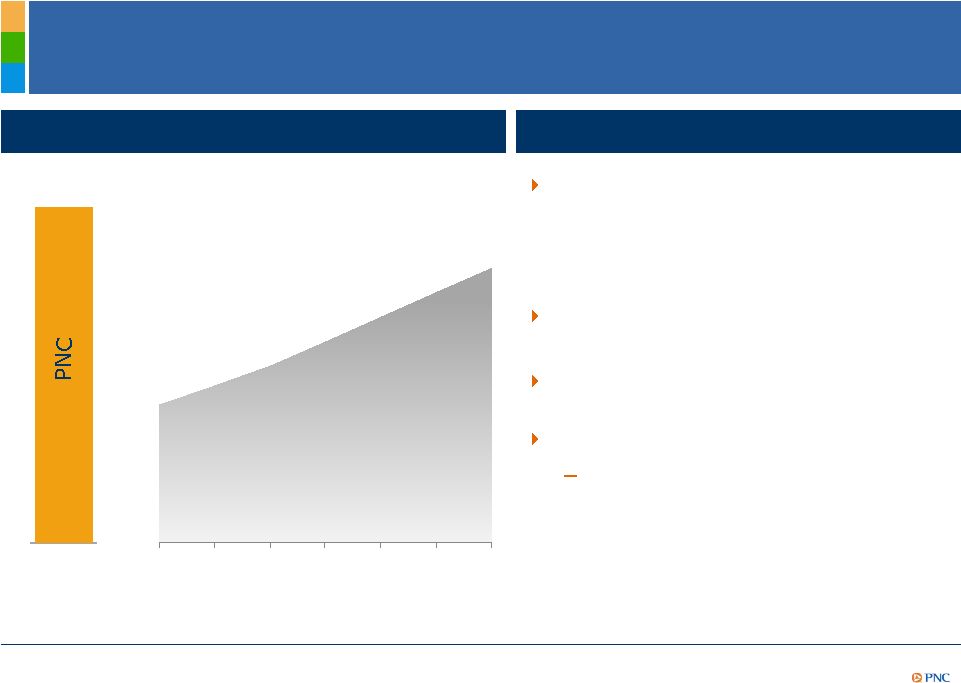
19
3.5%
4.0%
4.5%
5.125%
5.75%
6.375%
7.0%
2013
2014
2015
2016
2017
2018
2019
Highlights
The amount of cushion we choose to hold
above and beyond Basel III limits will be
a function of multiple inputs such as
economic conditions, AOCI cushion and
SIFI buffer, if required
Assumes no common stock issuance to
fund acquisition of RBC Bank (USA)
BlackRock
Return on economic and
regulatory capital is greater than 20%
Sub-investment grade securities
Significant upside potential assuming
capital requirements reflect the
inherent risk profile of the relevant
investment
Tier 1 common ratio
(1) Proforma estimate is based on PNCs Tier 1 common ratio of 10.5% as of 6/30/11, and
includes the assumed benefit of 1.3%, which reflects First Call 2011 and 2012 estimates
and current dividend payout, as well as the assumed decrease of 3.3%-3.8%, which reflects assumptions
regarding credit, operating and market risk under Basel II, the treatment of BlackRock and
sub-investment grade securities (assuming no AOCI double counting) under Basel II,
and assumes no common share issuance for the RBC Bank (USA) acquisition. This estimate is subject to
further regulatory guidance and clarity. (2) Regulatory requirements include capital
conservation buffer. Basel III requirements
12/31/12
Proforma Basel III
8.0% -
8.5%
1
2
PNCs Basel III Capital Ratio Estimate |

20
Summary
PNC Continues to Build a Great Company.
PNC Continues to Build a Great Company.
PNCs proven business model and consistent
execution have delivered strong results throughout
the cycles
Clear levers to drive quality growth in the future
Relative valuation gap represents significant long-
term value |

21
Cautionary
Statement
Regarding
Forward-Looking
Information
Appendix
This presentation includes snapshot information about PNC used by way of
illustration and is not intended as a full business or financial review It should not be
viewed in isolation but rather in the context of all of the information made available by PNC in its SEC filings.
We also make statements in this presentation, and we may from time to time make other
statements, regarding our outlook for earnings, revenues, expenses, capital levels,
liquidity levels, asset quality and other matters regarding or affecting PNC and its future business and
operations that are forward-looking statements within the meaning of the Private
Securities Litigation Reform Act. Forward-looking statements are typically
identified by words such as believe, plan, expect, anticipate, see, intend, outlook, project, forecast, estimate,
goal, will, should and other similar words and
expressions. Forward-looking statements are subject to numerous assumptions, risks and
uncertainties, which change over time.
Forward-looking statements speak only as of the date made. We do not assume any duty
and do not undertake to update forward-looking statements. Actual results or
future events could differ, possibly materially, from those anticipated in forward-looking statements, as well as
from historical performance.
Our forward-looking statements are subject to the following principal risks and
uncertainties.
Our businesses, financial results and balance sheet values are affected by business and
economic conditions, including the following: o
Changes in interest rates and valuations in debt, equity and other financial markets.
o
Disruptions in the liquidity and other functioning of U.S. and global financial markets.
o
The impact on financial markets and the economy of the downgrade by Standard &
Poors of U.S. Treasury obligations and other U.S. government-backed debt, as
well as issues surrounding the level of U.S. and European government debt. o
Actions by Federal Reserve, U.S. Treasury and other government
agencies, including those that impact money supply and market interest rates.
o
Changes in customers, suppliers and other counterparties performance and
creditworthiness. o
Slowing or failure of the current moderate economic recovery.
o
Continued effects of aftermath of recessionary conditions and uneven spread of positive
impacts of recovery on the economy and our counterparties, including adverse impacts
on levels of unemployment, loan utilization rates, delinquencies, defaults and
counterparty ability to meet credit and other obligations.
o
Changes in customer preferences and behavior, whether due to changing business and economic
conditions, legislative and regulatory initiatives, or other factors.
Our forward-looking financial statements are subject to the risk that economic and
financial market conditions will be substantially different than we are currently
expecting. These statements are based on our current view that the moderate economic recovery is transitioning into a
self-sustaining economic expansion in 2011, with faster economic growth in the second half
pushing the unemployment rate lower amidst continued low interest rates.
Our forward-looking financial statements are subject to the risk that economic and
financial market conditions will be substantially different than we are currently
expecting. These statements are based on our current view that the modest economic expansion will persist in the year
ahead and interest rates will remain very low.
|

22
Cautionary Statement Regarding Forward-Looking
Information (continued)
Appendix
Legal and regulatory developments could have an impact on ability to operate our businesses,
financial condition, results of operations, competitive position, reputation, or
pursuit of attractive acquisition opportunities. Reputational impacts could affect matters such as business
generation and retention, liquidity, funding, and ability to attract and retain
management. These developments could include: o
Changes resulting from legislative and regulatory reforms, including broad-based
restructuring of financial industry regulation and changes to laws and regulations
involving tax, pension, bankruptcy, consumer protection, and other industry aspects, and changes in
accounting policies and principles. We will be impacted by extensive reforms provided
for in the Dodd-Frank Wall Street Reform and Consumer Protection Act (the
Dodd-Frank Act) and otherwise growing out of the recent financial crisis, the precise nature, extent
and timing of which, and their impact on us, remains uncertain.
o
Changes to regulations governing bank capital, including due to the Dodd-Frank Act and to
Basel III initiatives. o
Unfavorable resolution of legal proceedings or other claims and regulatory and other
governmental investigations or other inquiries. In addition to matters relating
to PNCs business and activities, such matters may include proceedings, claims, investigations, or
inquiries relating to pre acquisition business and activities of acquired companies, such as
National City. These matters may result in monetary judgments or settlements or
other remedies, including fines, penalties, restitution or alterations in our business practices,
and in additional expenses and collateral costs, and may cause reputational harm to PNC
following the acquisition and integration of acquired businesses into ours.
o
Results of regulatory examination and supervision process, including our failure to satisfy
requirements of agreements with governmental agencies.
o
Impact on business and operating results of any costs associated with obtaining rights in
intellectual property claimed by others and of adequacy of our intellectual property
protection in general. Business and operating results are affected by our ability to identify and effectively manage
risks inherent in our businesses, including, where appropriate, through effective use of
third-party insurance, derivatives, and capital management techniques, and to meet evolving regulatory
capital standards. In particular, our results currently depend on our ability to manage
elevated levels of impaired assets. Business and operating results also include impacts relating to our equity interest in
BlackRock, Inc. and rely to a significant extent on information provided to us by
BlackRock. Risks and uncertainties that could affect BlackRock are discussed in more detail by BlackRock in SEC
filings.
Our planned acquisition of RBC Bank (USA) presents us with risks and uncertainties related
both to the acquisition transaction itself and its integration into PNC after closing,
including: o
Closing is dependent on, among other things, receipt of regulatory and other applicable
approvals, the timing of which cannot be predicted with precision at this point and
which may not be received at all. The impact of closing on PNCs financial statements will be
affected by the timing of the transaction.
o
The transaction (including integration of RBC Bank (USA)s businesses) may be
substantially more expensive to complete than anticipated. Anticipated benefits,
including cost savings and strategic gains, may be significantly harder or take longer to achieve than
expected or may not be achieved in their entirety as a result of unexpected factors or
events. o
Our ability to achieve anticipated results from this transaction is dependent also on the
following factors, in part related to the state of economic and financial
markets: the extent of credit losses in the acquired loan portfolios and the extent of deposit attrition. Also,
litigation and governmental investigations that may be filed or commenced, as a result of
this transaction or otherwise, could impact the timing or realization of anticipated
benefits to PNC.
|

23
Cautionary Statement Regarding Forward-Looking
Information (continued)
Appendix
o
Integration of RBC Bank (USA)s business and operations into PNC, which will include
conversion of RBC Bank (USA)s different systems and procedures, may take longer
than anticipated or be more costly than anticipated or have unanticipated adverse results relating to RBC Bank
(USA)s or PNCs existing businesses. PNCs ability to integrate RBC Bank
(USA) successfully may be adversely affected by the fact that this transaction will
result in PNC entering several markets where PNC does not currently have any meaningful retail presence.
In addition to the planned RBC Bank (USA) transaction, we grow our business in part by
acquiring from time to time other financial services companies, financial services
assets and related deposits. These other acquisitions, including our planned acquisition of branches and related deposits
in metropolitan Atlanta, Georgia from Flagstar Bank, FSB, often present risks and
uncertainties analogous to those presented by the RBC Bank (USA) transaction, as well
as, in some cases, with risks related to entering into new lines of business.
Competition can have an impact on customer acquisition, growth and retention and on
credit spreads and product pricing, which can affect market share, deposits and
revenues. Industry restructuring in the current environment could also impact our business and financial performance through
changes
in
counterparty
creditworthiness
and
performance
and
in
competitive
and
regulatory
landscape.
Our
ability
to
anticipate
and
respond
to
technological changes can also impact our ability to respond to customer needs and meet
competitive demands. Business
and
operating
results
can
also
be
affected
by
widespread
disasters,
dislocations,
terrorist
activities
or
international
hostilities
through
impacts on the economy and financial markets generally or on us or our counterparties
specifically. We
provide
greater
detail
regarding
some
of
these
factors
in
our
2010
Form
10-K
and
first
and
second
quarter
2011
Form
10-Qs,
including
Risk
Factors and Risk Management sections of those reports, and our subsequent SEC filings.
Our forward-looking statements may also be subject to other risks and
uncertainties, including those we may discuss elsewhere in this presentation or in SEC filings, accessible on the SECs website at
www.sec.gov and on our corporate website at www.pnc.com/secfilings. We have included
these web addresses as inactive textual references only. Information on these
websites is not part of this document. Any annualized, proforma, estimated, third party
or consensus numbers in this presentation are used for illustrative or comparative purposes only and
may not reflect actual results. Any consensus earnings estimates are calculated based on
the earnings projections made by analysts who cover that company. The
analysts opinions, estimates or forecasts (and therefore the consensus earnings
estimates) are theirs alone, are not those of PNC or its management, and may not
reflect PNCs or other companys actual or anticipated results. |

24
Non-GAAP to GAAP Reconcilement
Appendix
Six months ended June 30
in millions
2011
2010
2009
2008
2007
Reported net income
$1,744
$3,397
$2,403
$914
$1,491
Average assets
$261,826
$264,902
$276,876
$142,020
$123,418
Return on average assets
1.34%
1.28%
0.87%
0.64%
1.21%
Adjustments
$0
$639
(1)
$1,076
(2)
$0
$0
Income taxes
0
311
389
0
0
After-tax adjustments
$0
$328
$687
$0
$0
Net income excluding adjustments
$1,744
$3,069
$1,716
$914
$1,491
Average assets
$261,826
$264,902
$276,876
$142,020
$123,418
Return on average assets excluding adjustments
1.34%
1.16%
0.62%
0.64%
1.21%
(1) Gain on sale of GIS
(2) Gain on BlackRock/BGI transaction
PNC
believes
that
information
adjusted
for
the
impact
of
certain
items
may
be
useful
due
to
the
extent
to
which
the
items
are
not
indicative
of
our
ongoing operations.
Year ended December 31
As of
$ in millions
June 30, 2011
Allowance for loan and lease losses
$4,627
Remaining mark on purchased impaired loans
$1,234
Allowance for loan and lease losses, adjusted to include remaining mark
$5,861
Loans, as reported
$150,319
Loans, adjusted to include remaining mark on purchased impaired loans
$151,553
Allowance for loan and lease losses to loans
3.08%
Allowance for loan and lease losses plus remaining mark to loans plus remaining mark
3.87% |

25
Non-GAAP to GAAP Reconcilement
Appendix
In millions except per share data
Dec. 31, 2007
June 30, 2011
Common shareholders' equity
$14,854
$31,588
Common shares outstanding
335
526
Book value per common share
$43.60
$60.02
Intangible assets
$8,853
$9,005
Common shareholders' equity less intangible assets
$6,001
$22,583
Common shares outstanding
335
526
Tangible book value per common share
$17.91
$42.93
As of
PNC
believes
that
tangible
book
value
per
common
share,
a
non-GAAP
measure,
is
useful
as
a
tool
to
help
evaluate
the
amount,
on
a
per
share
basis,
of
intangible
assets included in book value per common share.
In millions
June 30, 2010
Sep. 30, 2010
Dec. 31, 2010
Mar. 31, 2011
June 30, 2011
Net income, as reported
$803
$1,103
$820
$832
$912
Adjustment:
After-tax gain on sale of GIS
-
328
-
-
-
Net income, as adjusted
$803
$775
$820
$832
$912
Adjusted net income, annualized
$3,221
$3,075
$3,253
$3,374
$3,658
Common shareholders' equity
27,731
29,396
29,595
30,485
31,588
Intangible and other assets
10,450
9,111
9,053
9,008
9,005
Tangible common shareholders' equity
$17,281
$20,285
$20,542
$21,477
$22,583
Return on tangible common equity
19%
15%
16%
16%
16%
As of |

26
Peer Group of Banks
Appendix
The PNC Financial Services Group, Inc.
PNC
BB&T Corporation
BBT
Bank of America Corporation
BAC
Capital One Financial, Inc.
COF
Comerica Inc.
CMA
Fifth Third Bancorp
FITB
JPMorgan Chase
JPM
KeyCorp
KEY
M&T Bank
MTB
Regions Financial Corporation
RF
SunTrust Banks, Inc.
STI
U.S. Bancorp
USB
Wells Fargo & Co.
WFC
Ticker |